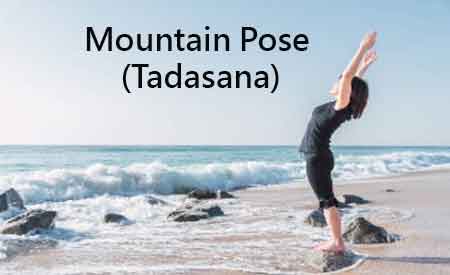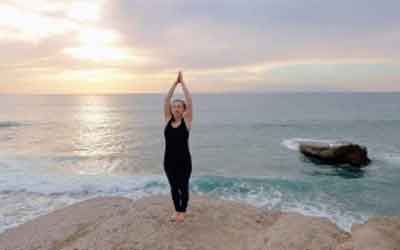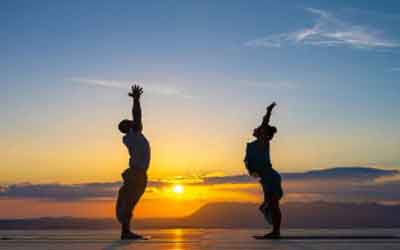What is Mountain pose?
Mountain pose alias Tadasana or Samasthiti in Sanskrit is also known as standing asana or pose in modern yoga exercises. Mountain pose (Tadasana) is a foundational yoga pose that involves standing erect with your feet firmly grounded over the floor with your arms at your sides. This pose is commonly practiced at the beginning and end of any yoga session.

what is mountain pose (tadasana)
The mountain pose (Tadasana) is the cornerstone of all standing postures. The pose is unique and simple that can help you to improve posture and alignment of the body. Practicing the Mountain pose (Tadasana) at regular intervals can eradicate spinal inflammation or severe issues related to poor posture.
Meaning of Tadasana (Mountain pose)
Tadasana (Mountain pose) is a Sanskrit word conventionally known as mountain poses in English. It is a foundational yoga posture, commonly used as a starting point for other standing postures. The word Tadasana originates from Sanskrit, where “Tad” means “mountain” while asana means “pose”.
To all intent and purposes, the pose mimics the qualities of a mountain- strong, stable and grounded. That is why while practicing this pose, you can feel a sense of groundedness and stability as if you are rooted firmly into the earth and a sense of lightness and lift as if your entire body is reaching towards the sky.
One of the key benefits of Tadasana (Mountain pose) is that it can help you build strength and stability in your entire body structure. By engaging your leg muscles and core, you can improve your balance, perennially and stability, which can benefit you in other yoga postures and your daily regime.
Origin of Mountain Pose (Tadasana)
As explained earlier, the Mountain pose (Tadasana) is derived from the Sanskrit word “Tad”, Meaning Mountain, and “Asana”, meaning posture, which resembles a mountain standing firmly irrespective of the demographical conditions. The Mountain pose (Tadasana) does not have any description in the manuscript of Hatha yoga (Hatha yoga is a classical text of asanas or physical poses and their effects upon the human body) till the 20th century.

mountain yoga pose tadasana
But it proves its existence in the Vyayam Dipika in 1896(Vyayam Dipika is a gymnastics manual which explains an ancient sequence of exercises with the help of sticks). Later, the pose was included in modern yoga as exercise and finally became a foundational pose for almost all standing poses and asanas.
Today in modern yoga Mountain pose (Tadasana) is also considered an elementary pose in Ashtanga Vinyasa yoga and Iyengar yoga (Ashtanga Vinyasa yoga and Iyengar yoga are based on breath and posture methodologies and techniques for a wholesome lifestyle.
Yogic Explanation of Tadasana (Mountain pose)
Mountain pose (Tadasana) is a revolutionary primal posture beneficial for both the physical and subtle energy body. From a physical perspective, Tadasana helps to improve posture and alignment. By standing with the feet hip-distance apart and rooting them firmly into the ground, the muscles in the feet, legs, and core are engaged, which helps to support the spine and promote better posture.
Tadasana also helps stretch and lengthen the spine, relieving tension and strain in the neck, shoulders, and back. From a subtle energy perspective, Tadasana (Mountain pose) helps balance the root chakra, or Muladhara, located at the base of the spine. The root chakra is associated with grounding, stability, and a sense of security, and it is considered the foundation of the entire chakra system.
By practicing Tadasana, the root chakra is activated and balanced, which can help to promote feelings of safety and stability. Tadasana also helps to promote prana, or life force energy, throughout the body. Standing tall and lifting the crown of the head towards the sky, the energy channels in the body are opened, allowing prana Shakti to flow more freely.
This increased flow of prana can help to improve overall health and well-being. Finally, Tadasana (Mountain pose) encourages mindfulness and awareness. Focusing on the breath and the sensations in the body brings the mind into the present moment, which can help reduce stress and anxiety.
Tadasana (Mountain pose) also promotes a sense of connection to the earth and the sky, which can foster a deeper sense of spirituality and connection to something greater than oneself.

what is tadasana
How to practice Mountain pose (Tadasana)?
Mountain pose (Tadasana) is a flagrant base pose that helps to terminate several issues related to bad posture. Here are some simple steps to start practicing this pose
- Begin standing straight with your feet hip-distance apart and your toes pointing forward.
- Distribute your weight evenly across both feet
- Now stretch your arms over your head straight, locking your fingers and palms facing upwards
- Now, lift your shoulders and hold your breath for 15-30 seconds.
- Release your breath and shoulders back and down away from your ears
- Relax your body and face muscles, including your throat.
- Repeat all the steps in a similar fashion and practice the Mountain pose (Tadasana) regularly for 2-3 months to find better results.
Additional tips while practicing mountain pose (Tadasana)
Here are some additional tips to keep in mind while practicing the pose:
- Keep your weight evenly distributed between both feet. Avoid shifting your weight to one foot or another, creating imbalance and strain on the joints.
- If you have tight hamstrings or lower back, you may find it helpful to slightly bend your knees to release tension and allow your pelvis to tilt more easily.
- Stay away from expanding your lower spine region as it can contract the lower spine area and can cause injury to underneath muscles.
- Loosen your collar bone region, especially your shoulders, neck and your facial muscles and jaw. Let go of any stress in your body and allow yourself to feel calm and peaceful.
- Try to be calm while practicing the pose as it needs tolerance and practice to retain the actual pose.
Advantages of practicing mountain pose (Tadasana)
- Promotes correct Alignment: Regular practice of Mountain pose (Tadasana) aids to retain correct body alignment and desirable spine position. While practicing the pose you can break the pose at regular intervals to feel more confident and avoid fatigue overcome you.
- Relieves Restlessness and Uneasiness: Practicing the pose assists you to relieve from any kind of uneasiness and restlessness. You will feel more centered and relaxed by focusing on your breath and standing still.
- Relieves back pain: Mountain pose (Tadasana) helps to stretch and strengthen the muscles in your back, which can relieve back pain. By standing tall and pulling your shoulder back, you will feel comfort throughout your back muscles.
- Improves circulation: The pose helps to improve blood circulation throughout the body. Standing tall and engaging your leg muscles will encourage blood flow to your lower body.
- Gives strength to lower body frame: Regular practice of Mountain pose (Tadasana) promotes power and strength to underneath body frame or lower body area including thighs, ankles, leg muscles and feet.
- Minimizes backache: Regular practice of Mountain pose (Tadasana) aids to subside backache or inflammation in the back region. By standing tall and engaging your leg muscles, you’ll gently stretch the muscles that can cause sciatica pain.
- Contributes to a healthy body: Regular practicing of Mountain pose (Tadasana) promotes strength and vitality to the whole body.
- Promotes liveliness and potency: Regular practice of Mountain pose (Tadasana) tends to increase the flow of blood throughout the body which tends to throw out the harmful toxins in the body through urination, leaving an energetic body with liveliness and higher potency level.
Major Injuries and helpful tips to avoid injuries while practicing Mountain pose (Tadasana)
While mountain pose (Tadasana) is generally a safe and accessible pose, there is still a potential risk of injury, especially if proper alignment and technique are not maintained. Here are a few potential injuries and helpful tips to avoid them while practicing Tadasana:
- Lower Back Pain: Lower back pain is often caused by over-arching the lumbar spine. To avoid this, maintain a neutral spine in Mountain pose (Tadasana), drawing the belly button towards the spine and engaging the core muscles. Also, avoid leaning too far forward or backwards, and maintain a balanced weight distribution between both feet.
- Neck Pain: Neck pain can occur if the head is not properly aligned with the spine in the Mountain pose (Tadasana). Make sure to lengthen through the crown of the head and avoid tucking the chin or moving the head forward. Ease your shoulders and keep them distant from ears.
- Hip Pain: Hip pain can be caused by poor alignment balances. Keep your groin area muscles still. To and fro movements or uneven movement of legs can cause injury or inflammatory spine.
- Thigh injury: Mind to perform a warm up exercise and short stretching before start practicing the Mountain pose (Tadasana). Also, avoid overstretching the thighs by slightly bending the knees.
- Plantar Fasciitis: Plantar Fasciitis is a common condition when the tissue that runs along the bottom of the foot, becomes inflamed. To avoid this, properly warm up the feet and engage the muscles of the feet and toes in Tadasana. Avoid collapsing the arches of the feet or standing on the inside or outside edges of the feet.
In summary, practicing Tadasana mindfully with proper alignment and gradual progression can help you avoid injury. If you are in pain or discomfort, back off and modify the pose as needed. As always, consult a qualified yoga before practicing an exercise pose.
Contraindications and limitations of practicing mountain pose (Tadasana)
Inspite of numerous benefits there are a few contraindications and limitations to keep in mind when practicing this pose:
- Low bone Density: People suffering from low bone density should not try this pose. People with weak bones or low bone density could lead to fracture or osteoporosis.
- Damaged Optic nerve: People suffering from damaged optic nerve or Glaucoma should avoid this pose, as it can completely damage the optic nerve and one can lose his/her vision permanently.
- Neck problems: Individuals with neck injuries or cervical spine issues should avoid looking up in Mountain pose, as it can aggravate their condition.
- Balance issues: People with balance problems or a history of falls should practice Mountain pose (Tadasana) with caution, using a wall or chair for support.
- Back problems: People with chronic back problems should avoid practicing Tadasana if it causes pain or discomfort. Modifications can be made to the pose to make it more accessible.
- Joint issues: People with joint problems, such as arthritis, should avoid practicing Mountain pose (Tadasana) if it causes discomfort or pain.
Always try to listen to your body while practicing the pose. Make any necessary changes required by the body to make the pose more comfortable. It is highly advised to seek medical advice in case of any medical condition in the past.
Summary of Mountain pose (Tadasana)
Mountain Pose (Tadasana), is basically a foundational yoga posture which involves standing straight with feet hip distant apart and weight of the body evenly distributed to the ground. It is often used to start other standing poses and to find a sense of grounding and stability in the body and mind. Like other poses in modern Yoga, Mountain pose (Tadasana) has numerous benefits to the human body including strengthening of core muscles, promoting improved body posture and achieve desired body alignment. It also helps to reduce stress and anxiety promoting a healthy mind.
Frequently Asked Questions
(Q-1) Can Mountain pose (Tadasana) be practiced by beginners?
(A) Yes, Mountain pose (Tadasana) is a foundational yoga exercise and can be practiced at all age groups under the guideline of a trained yoga instructor.
(Q-2) Does Mountain pose (Tadasana) reduce stress and anxiety?
(A) Yes, Mountain pose (Tadasana) helps to increase focus, calms the mind and reduces stress and anxiety.
(Q-3) Is it necessary to practice Mountain pose (Tadasana) regularly?
(A) No, it is not mandatory to practice Mountain pose (Tadasana) regularly but if practiced at regular intervals on daily basis, it could be more beneficial.
(Q-4) Can I modify the Mountain pose (Tadasana) during practice?
(A) Yes, you can modify the pose during the practice as per your comfort level. At beginners level you can break the pose at regular intervals and you can continue the pose as you regain your energy.
(Q-5) Can pregnant ladies practice Mountain pose (Tadasana)?
(A) Mountain pose (Tadasana) can be practiced by anyone especially pregnant ladies but it is advised to seek medical advice before start practicing the pose.
Read more articles
What is Bow Pose (Dhanurasana)?
How to Become an International Yoga Instructor?
Join Our Facebook Page
Author
Bhavika Panesar



